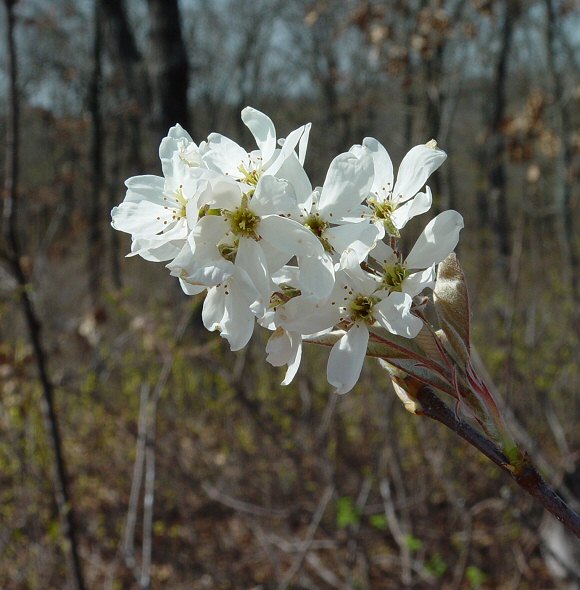Amelanchier arborea (F. Michx.) Fernald
Downy Serviceberry

Native
CC = 6
CW = 3
MOC = 79
© DETenaglia
Amelanchier arborea (F. Michx.) FernaldDowny Serviceberry | |
 |
Native CC = 6 CW = 3 MOC = 79 |
© DETenaglia |
|
Family - Rosaceae Habit - Small trees to 16 m, or shrubs. Stems - Bark smooth, gray, becoming shallowly furrowed and scaly with age. Twigs orangish brown to purplish brown, with small white lenticels, glabrous, usually glaucous, the leaf buds narrowly elliptic lanceolate, sharply pointed at the tip, with several overlapping scales, these greenish yellow to light brown, at maturity often strongly tinged with red or purple.
Leaves - Leaves alternate, petiolate, the petioles densely pubescent when young, glabrous or nearly so at maturity. Stipules 9-15 mm long, linear, pinkish to reddish purple, shed during leaf development. Leaf blades simple, unlobed, to 10 cm, the margins sharply toothed, sharply pointed, cordate at base.
Inflorescences - Short racemes at branch tips, produced slightly before leaves unfold, axis densely hairy at flowering but nearly glabrous by fruiting. Flowers subtended by hairy bracts which are shed as the flowers open.
Flowers - Epigynous, the hypanthium fused to the ovaries, hairy at flowering, the rim with a nectar disc. Sepals 5, spreading to recurved, hairy on the outer surface, persistent at fruiting. Petals 5, oblanceolate to strap-shaped, often somewhat lax or drooping, white or rarely pink. Stamens 15-20, the anthers yellow. Pistils 5. Ovaries inferior, fused along the lateral surfaces and dorsally to the hypanthium at flowering, but with the inner sides free until the fruit develops, each with 2 ovules. Styles 5, fused toward the base, the stigmas more or less disc-shaped.
Fruits - Globose pomes, 6-10 mm long, turning red, then reddish purple at maturity. Seeds 3.5-5.0 mm long, obliquely elliptic to lanceolate in outline, somewhat flattened, the surface smooth to slightly roughened, dark purplish brown. Flowering - March - May. Habitat - Open rocky woods, bluffs, borders of glades, typically in well drained soil. Origin - Native to U.S. Lookalikes - None close. From a distance, the flowering tree is sometimes mistaken for flowering dogwood (Cornus florida), but the flowers are totally different up close. Other info. - This striking tree can be found throughout Missouri but is apparently absent from the "bootheel" counties and a few counties in the northwest corner of the state. The plant is one of the first woodland understory trees to bloom in the spring and its numerous masses of white flowers are hard to miss. It is perhaps most beautiful to behold on a gray, cloudy day when the flower clusters can appear almost luminous in contrast. The smooth gray bark and spreading trunks make the species easy to identify in the field. Photographs taken at Whetstone Creek Conservation Area, Callaway County, MO., 2-19-04, and at Dave Rock Conservation Area, St. Clair County, MO., 4-3-04 (DETenaglia); also at Tyson County Park, St. Louis County, MO, 3-30-2011, Holly Ridge Conservation Area, Stoddard County, MO, 4-11-2018, and at Valley View Glade Natural Area, Jefferson County, MO, 4-11-2014 (SRTurner). |